In "Ma-No" we have tried to make some predictions with our digital crystal ball and (knowing that we will be wrong about many things) about what will happen in SEO in the next months. These are the ten trends that could mark the evolution of web positioning in 2020.
1. More Schema and new featured snippets
Google is making great strides towards fully semantic information retrieval. Meanwhile, it keeps asking us to add Schema.org's structured data markup to our HTML code.
The definition of new schemes has increased exponentially since its launch in 2011. Below you can see the schemes defined at the time of the launch (http://web.archive.org/web/20110728002346/https://schema.org/docs/full.html) with respect to those currently available (https://schema.org/docs/full.html). Today we can choose from more than three times as many schemes as in 2011.
As a direct consequence of the expansion of schema.org and its massive implementation in more and more websites, Google is able to show the answer directly to more queries through the different formats of highlighted results.
If in the second half of this year the protagonist has been the application of the featured snippets of type FAQPage and HowTo, for next year we foresee:
1. New formats of outstanding results.
2. More control over the consistency between the landing page type and the featured result. For example, Google states in its usage guidelines for FAQPage that it should not be used for advertising purposes.
However, several travel websites have already found that this featured result is a good way to gain more visibility in SERPs. We predict that Google will end up vetoing the inclusion of this structured data tagging as the main entity in a clearly transactional landing. But until it does, let the party go on!
Otherwise, we continue with the controversy about whether featured snippets generate more or less CTR than a classic first result. As for so many other controversial questions in SEO, the answer is: it depends.
Indeed, it depends on whether the highlighted result is able to fully satisfy the user's search intention or not. In the first case, the CTR decreases radically, although it is not bad to highlight the impact on the branding obtained. In the second case, the CTR actually reaches figures above 70%.
We will have to continue testing to discover how to win this "extra ball" in the SERPs while taking care of the CTR and make the most of the branding effect.
2. From the NLP to the NLU
The implementation of Bidirectional Encoder Representations from Transformers (BERT) is a further step by Google on its way from Natural Language Processing (NLP) to Natural Language Understanding (NLU), i.e. a concept closer to understanding natural language as we humans do.
The key to a more accurate understanding of natural text lies in understanding the meaning of each word in the context of the other words in a sentence, rather than processing them linearly in the same order as they appear.
In the syntactic analysis, Google is able to place the function of each word and its relationship to the others in the context of the whole sentence.
As Google understands natural language better:
a) It will better identify the user's real need that underlies the search intention behind each keyword and, at the same time, it will be able to associate a given need with a multiplicity of different search formulations (neural matching).
b) It will better evaluate which content can best respond to the user's need, regardless of classic on and off-page relevance factors such as the presence of a given keyword in the page title or in the anchor text of the links.
c) It will depend less on indirect indicators of the quality or usefulness of a content, such as the authority and popularity calculated according to the quantity and quality of the links.
d) It will depend less on the semantic marking of the content, that is, on the application of the marking of structured data, to extract the valuable information.
This will put you in a position to extract the most relevant information and transform it into direct responses for users, using the rest of the Web as your own information repository. And this will happen whether we want (applying schema.org) or not.
All this seems to pave the way for Google to really become an indispensable assistant, capable of understanding natural spoken language and responding in the same way with the most relevant data for every need.
3. Entities in all result formats
The entities displayed help refine the image search in a similar way that Google Suggest suggestions help complete a text search. However, Google is likely to start showing relationships between entities as well, which expands the range of recognized entities and relationships.
The prediction at this point is a higher percentage of SERPs where the knowledge graph appears and Google shows other entities with which it relates the concept searched for, increasing what we already see in US results:
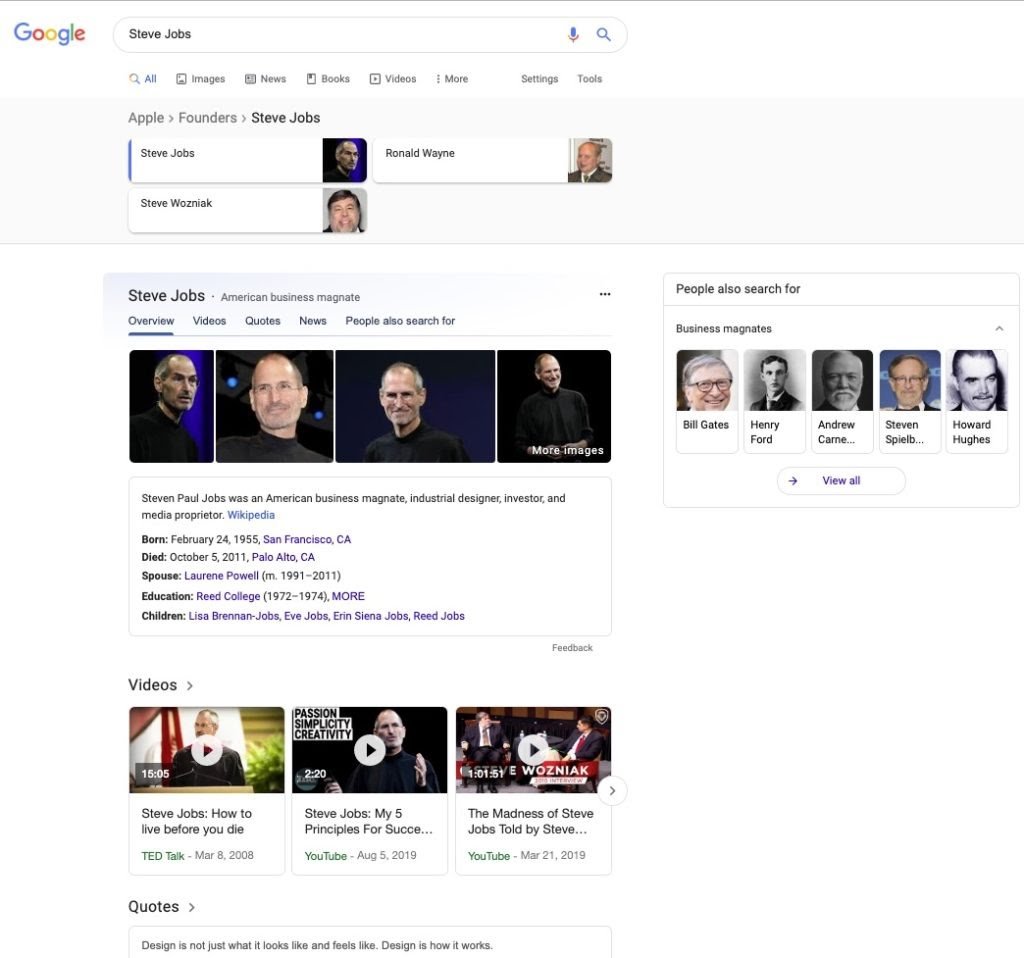
The recommendation to work on this concept would focus on making it easier for the searcher to identify these relationships as well as sources of authority to help validate them. That is, not only links, but references, even if they do not have links.
Presenting all these relationships directly in the results pages not only facilitates the refinement of the search for the user but, and this is the most important thing, statistically validates the relationships between the different entities. That is to say, it is the users who will confirm to the search engine which are the relationships between entities that are most relevant for the majority of people.
4. Increased weighting of user behaviour
This year there was a great deal of controversy as to whether user behavior might be gaining weight as a factor of relevance in SEO. Juan González, from Sistrix, published a very juicy post in 2016 with examples of changes in the results whose explanation seems to point to the influence of user behavior and Johannes Baus asked in another (Is user experience a positioning factor?) for this same question, especially after Gary Illyes denied similar hypotheses raised by Rand Fishkin.
The truth is that, regardless of how Google is incorporating user behaviour into its algorithm, any SEO has been able to see how the positions of different results change without the classic on and off page factors being affected.
Whatever the means used by Google to measure user satisfaction with a given result, we have no doubt that, like the development of semantic aspects, they will continue to gain weight at the expense of secondary quality indicators such as the classic on page (keyword density, presence of the keyword in prominent areas, etc.) and off page (quality, quantity and anchor text of the links) relevance factors.
If you can measure user response internally and directly, why would Google continue to rely on secondary external factors?
5. More variety of result formats
As a direct consequence of points 1, 2, 3 and 4, Google not only accesses, stores and sorts more information but also understands it and knows how to extract its added value. Not long ago the search engine started to show results like the following:
Calculadoras
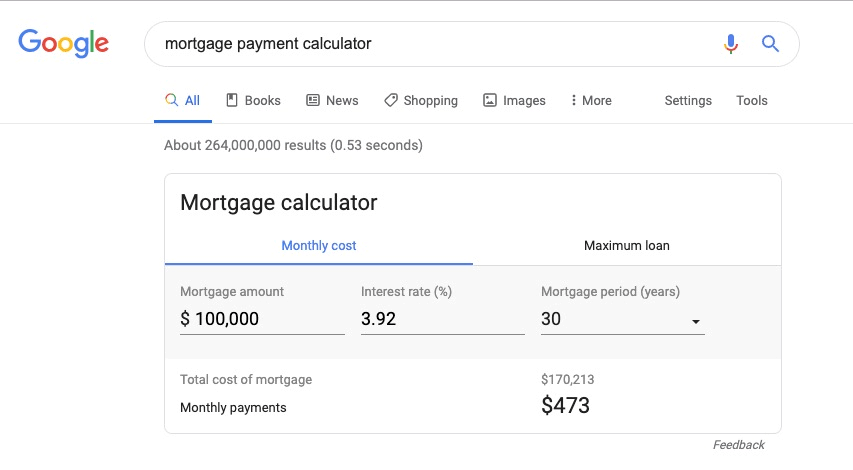
Or, for instance, search result carousels where two categories of entities are related, like this one from cheaper neighborhoods in New York:
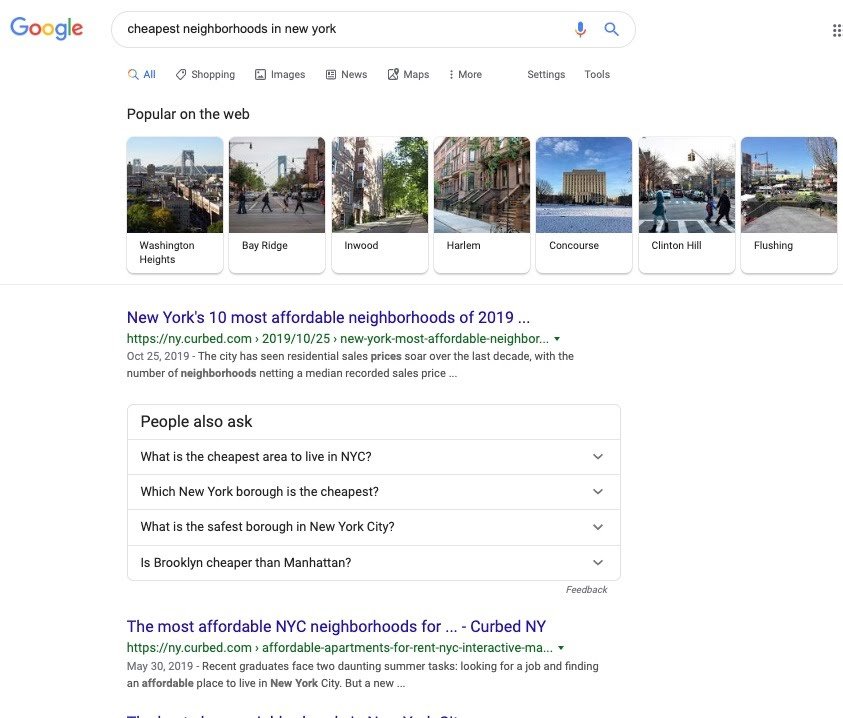
Google shows an increasing variety of outstanding results and for a higher percentage of results (in 2018, it showed featured snippets for 8% of the keywords according to this SEMrush study).
It is clear that the search engine is able to correctly interpret a greater complexity of search intentions and underlying needs in a more refined way. And its response is also increasingly accurate, making it unnecessary to resort to certain specialized vertical search engines.
Which brings us to point 6...
6. Impact on new verticals
Google doesn't want to act as a meta-search engine. If we give you all our information, why not offer it directly from your results?
6.1. Stock exchange price
For a stock price search, Google first displays a widget with direct information. Bad news for the economy, finance, investment and stock market media. Something that, in addition, is ready to jump to the Google assistant and its voice search.
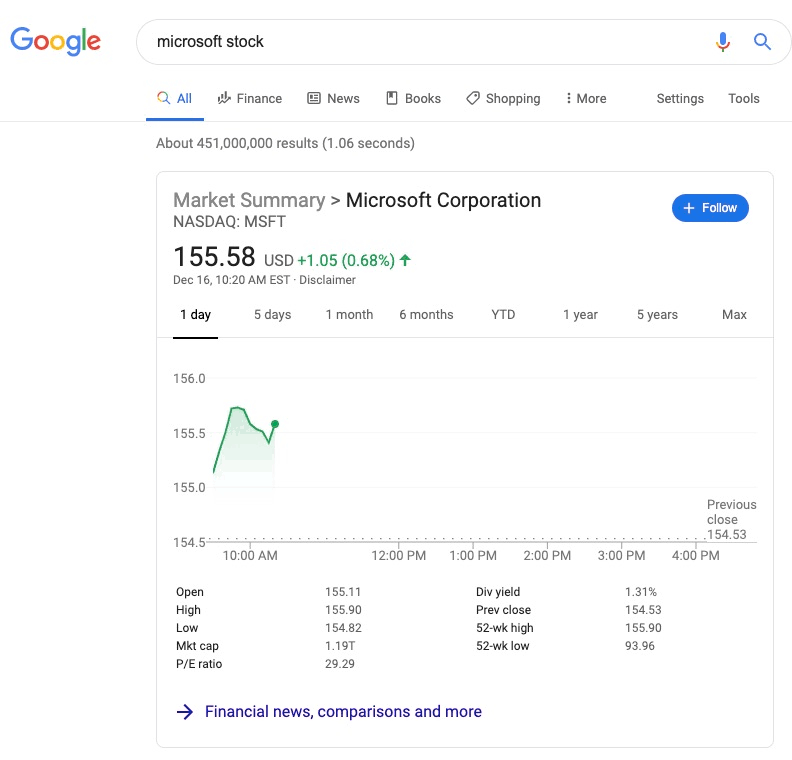
6.2. Flights
To find a route, Google already directly displays flight options from a variety of providers with prices, information on whether they are direct or with stopovers, dates, and airports of departure and arrival. All of these data are part of the Flight Scheme properties, as well as the status of a particular flight.
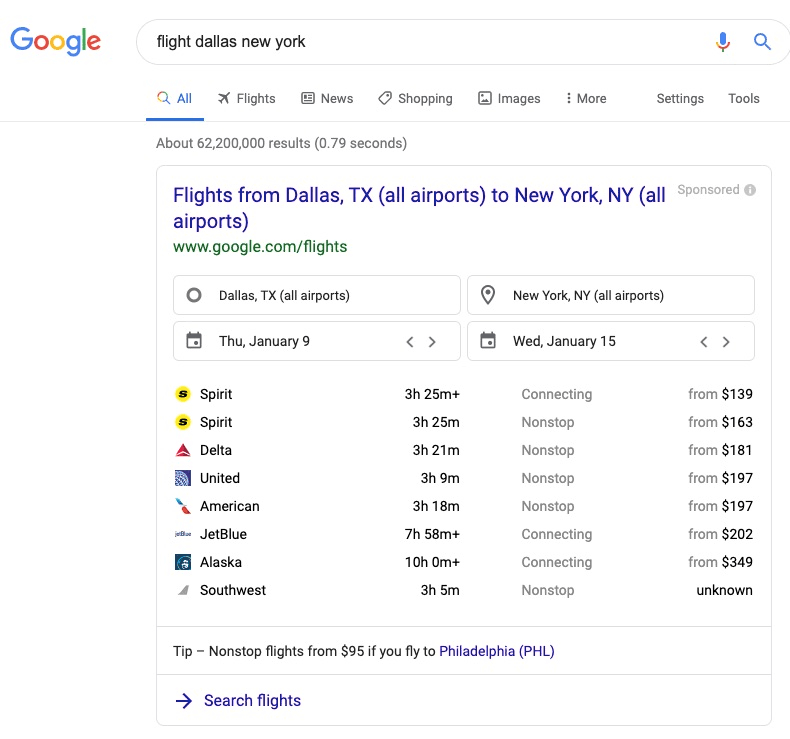
6.3. Hotels
The hotel search also presents direct results from the search engine, geolocated on maps, with evaluations of users, prices and the possibility of checking the availability of rooms by date. An entire hotel search engine without leaving the Google results pages, to which the price search by day was added in 2019.
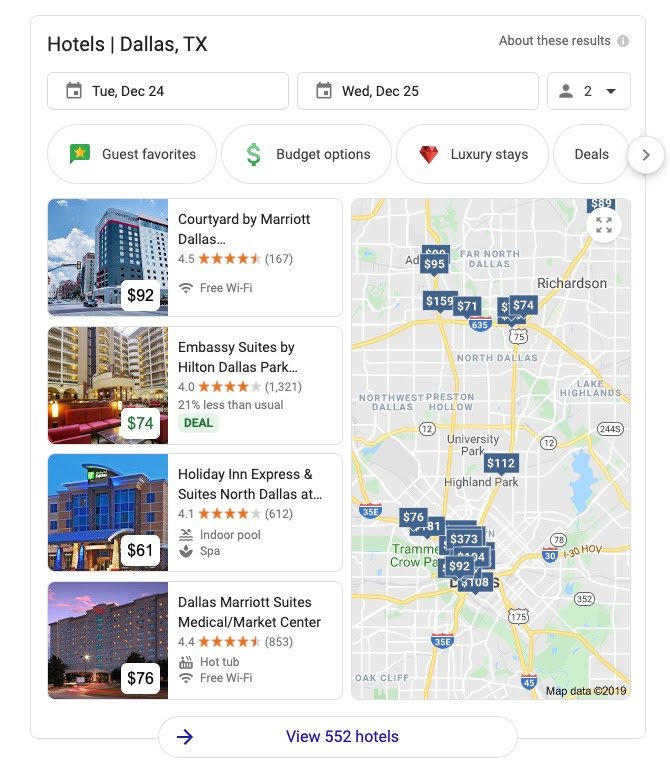
6.4. Ingredients and recipes
The search for recipes and ingredients has been the field of development of numerous niche sites. For the search of ingredients and recipes, Google begins to present direct results where it mixes ingredient carousels, recipe results along with a knowledge graph that brings together the most striking aspects of it.
In 2020 we will undoubtedly see the deployment of new performance formats that will compromise the viability of hitherto profitable portals. Among the candidates could be all those related to local tourist information, real estate portals, bibliographic information, instruction manuals, tables of specifications and technical data, advanced geographic information... and surely many others that we do not even suspect.
7. Lower CTR in organic
During 2019, we were able to see how the 2018 Sparktoro CTR study was confirmed by the data. Indeed, if you can check the CTR of top10 positions you will probably have noticed a drop in clicks that does not seem justified by the position.
Although we disagree with these Google moves, it seems that this is and will continue to be the scenario from now on. Along with organic positioning strategies, companies that have not yet done so will have to rethink their brand strategy, as building a strong branding seems to be the only way to protect themselves against a declining CTR.
8. Even more adaptation to the local+mobile
We are no longer in the age of mobile-first but practically mobile-only: the smartphone has become the device par excellence for accessing the Web. With tablet sales totally stagnant, mobile phones are emerging as the main access device, which favours a higher percentage of searches being interpreted as local by Google.
The local SEO strategy is therefore gaining importance and it is not surprising that with it Google is in a position to win the war against the big local directories, the 2.0 portals for social recommendations of hotels and restaurants as well as the local business websites themselves and, of course, their Facebook pages as a showcase for business acquisition.
By encouraging the filling in of information in Google MyBusiness as well as the voluntary contribution of content (photographs, opinions, etc.) or involuntary (navigation data, physical visit, permanence, etc. transmitted directly from our mobile terminals) the search engine attacks the most frequent local searches by sector (restaurants, hotels, shops, trades), by search intention (nearby, how to go to..., best shops of...) and by need (what to see, what to visit, when to go...).
In 2020 we believe that the Google MyBusiness interface will be further developed so that local businesses can build their website virtually on Google's result pages, and so that Google can have the information needed to meet any need from its voice assistant.
9. Advertising in voice results
As we see search and voice results gradually developing, one thing that escapes anyone is that, at least so far, it is not clear how organic information will coexist with advertising, as both have been the basis of Google's success over the past twenty years.
Can we wait for Google to "delight" us with an advertising wedge before giving us back the result of the featured snippet? Some kind of outstanding positioning for paid results...? Do we position for searches that start with OK, Google?
This last movement is the one that seems to be recommended from posts like this one from Search Engine Journal and this one from Effective Spend.
10. Google as the only ecosystem
The common thread of these ten trends that we have just reviewed is the attempt, less and less disguised by Google, to become the only ecosystem used by the majority of users.
With functionalities such as the search engine, the Chrome browser, Google Maps, Google MyBusiness, GMail, Docs, etc. Google aspires to become the closed Web that every company would like to have for itself, where the largest volume of users and information is available.
This was the intention of Microsoft at the time, and it was the competition authorities that put the brakes on the software giant's monopolistic aspirations. Google has already received severe fines in both the United States and Europe, and with the withdrawal of its two creators Sergey Brin and Larry Page, we no longer have anyone to demand that they respect its famous slogan: Don't be evil.

